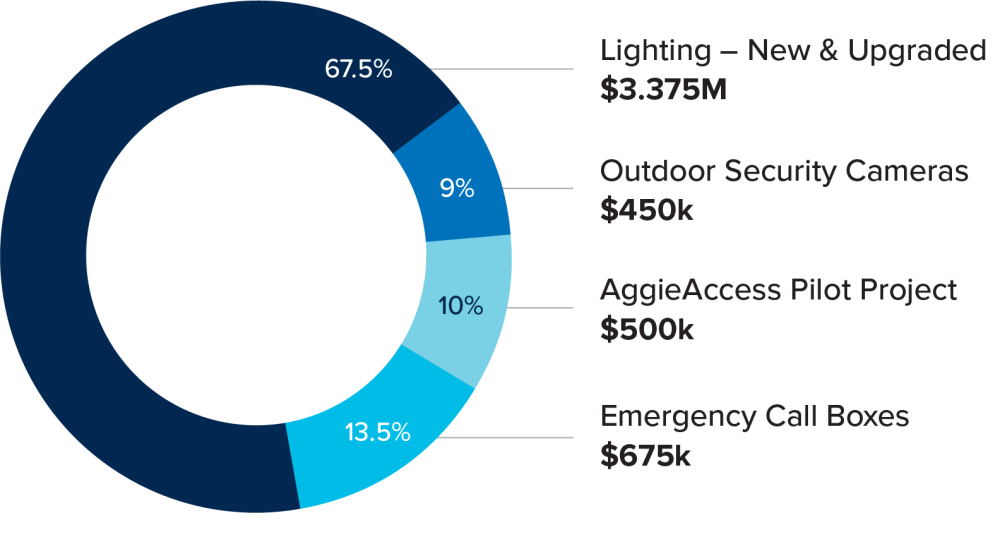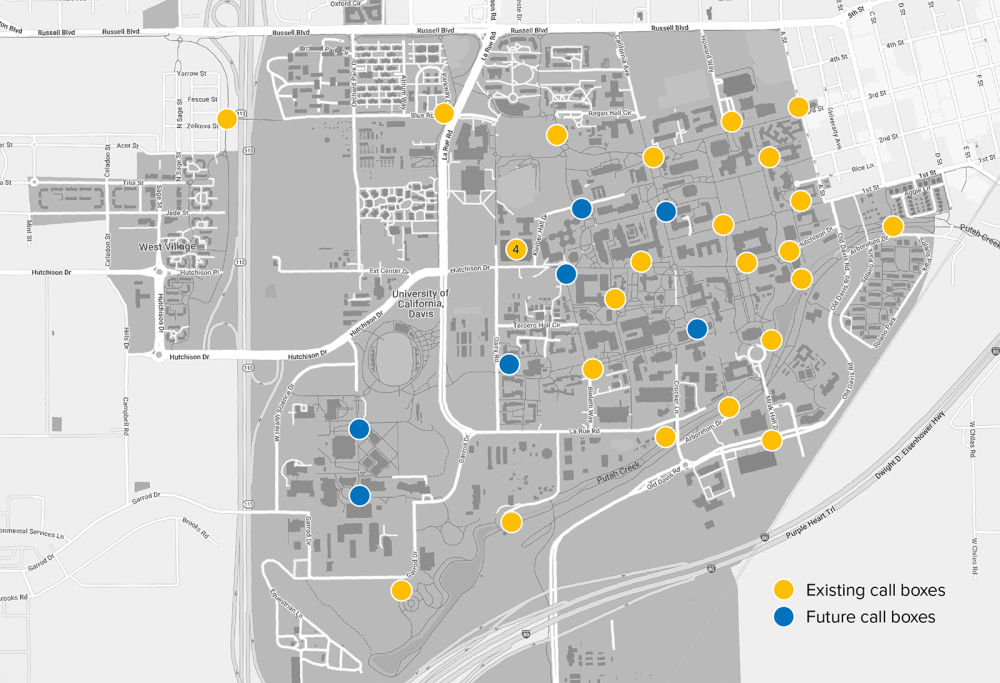UC Davis Invests in Additional Security Improvements
$20 Million Investment Adds More Lights, Call Boxes, Cameras, Building Security
Quick Summary
- Lighting safety walks have guided outdoor lighting improvements with input from students and community members.
- Additional $20 million builds on existing investments to accelerate updates to security infrastructure.
- Investments focus on four things: outdoor lighting, emergency call boxes, security cameras and building access systems.
UC Davis is investing more than $20 million in the next five years to continue to improve security infrastructure on campus. The investments focus on improved and expanded outdoor lighting, more emergency call boxes, additional security cameras and expanded card access to buildings.
The chancellor announced this additional investment in October 2023 as part of an ongoing commitment to enhance campus safety.
Locations for many of these additional security upgrades have been identified with help from students and others during the campus lighting safety walks — a proactive community practice at UC Davis for more than 15 years.
“We know that making the campus more secure requires continual upkeep, innovation and investment,” said Clare Shinnerl, vice chancellor for Finance, Operations and Administration. “Campus safety has been a long-standing priority, and the $20 million boost in funding helps accelerate infrastructure projects to proactively support our students, employees and many others.”
New investment adds to security updates already in progress

Shinnerl worked with a committee that helped prioritize plans for the new $20 million investment, with input from lighting walks and from experts in Facilities Management, Student Affairs, Design and Construction Management, Police, and Safety Services.
The committee’s plan for action invests $4.5 million toward priority improvements scheduled for completion in 2024-25 — including outdoor lighting, emergency call boxes and security cameras.
Also happening now is a $500,000 pilot project to improve security systems via AggieAccess in some of the campus’s older buildings.
After the pilot project is completed, a large portion of the remaining $20 million investment will go toward expanding AggieAccess to more buildings. Additional sites for outdoor lighting, call boxes and cameras will be identified, too.
These new investments join existing progress in campus security updates, including more than $7 million worth completed since 2020.
How lighting upgrades brighten campus
Any time outdoor lights are updated, the new lights must meet campus design standards, which offer several dimensions of improvement over older lighting styles.
“When we invest in campus lighting, it doesn’t always mean adding light poles,” said Joshua Morejohn, executive director of Utilities and Engineering. “It often means better lighting on existing poles — which can feel brighter while actually being more targeted and more efficient.”
Newer LEDs are 50-65% more energy-efficient than older lights. All new outdoor pathway fixtures include motion sensors and are “full cutoff,” which means they direct light downward only, to reduce glare and light pollution. Campus standards also call for higher quality light, with a color temperature that is considered warm white light (3000 K) and illuminates color more accurately than industry standards (90+ color rendering index, or CRI).

Follow these campus safety tips
The UC Davis Police Department shares safety tips related to traveling across campus at night, biking, walking, parking, locking doors, preparing for emergencies and more.
Many campus lighting upgrades have been guided by community feedback from the annual lighting safety walks. Approximately 94% of all problems identified in the January 2023 lighting walk were addressed before the $20 million allocation. Facilities managers estimate that, in general, more than 90% of issues identified by community members during annual lighting walks are fixed quickly.
Lighting upgrades from the new $20 million investment will focus on improving roughly 1 mile of pedestrian pathways in seven key locations by 2025, as identified by more recent lighting walks, academic departments and the committee.
Also happening this year:
- Lighting upgrades near Wickson and Wellman halls identified during previous lighting safety walks, with funding from UCOP’s Be Smart About Safety grants.
- Replacing globe lights along pathways on Shields Avenue and North Quad walkways with more efficient LED lights with motion sensors.
- Continuing to replace high-pressure sodium lights on exterior building walls with more efficient LED versions.
Improving emergency response with call boxes and cameras

The campus currently has 26 emergency call boxes in operation, including four call boxes installed recently. An additional seven call boxes are planned for completion by 2025, as part of this new investment. Each emergency call box has a bright blue light, a video camera and instant phone line to 911 dispatchers.
“Call boxes allow us to improve incident response to campus,” said Jeff Rott, security director for UC Davis Police.
“With a touch of a button, anyone can call for help — and we’ll know where they are without them needing to tell us. The 911 dispatchers can also see the camera footage from the 911 center, offering real-time information to an emergency responder," Rott said.
Those video cameras — along with other security cameras on campus — are checked in real time only when an alarm, 911 call or other campus incident is happening. Retrieving video footage after an incident requires a police report or other university investigation.
Whether they’re used for emergency response, facility security, parking or student housing security, there are about 1,150 cameras on campus, including about 236 that were installed since 2021.
“Our goal for security cameras on campus is to improve detection capabilities, especially around main building entries on campus and their adjacent bike rack areas,” Rott said.
AggieAccess to secure buildings with card locks and alarms
Another key part of the $20 million security investment is an expansion of the AggieAccess system.
Started in 2019, AggieAccess established a new centralized building access system for campus. The project began by updating existing card-reader door locks and installing card readers on new buildings. By now, about 1,650 card readers have been connected to this centralized system. For most users, digital credentials on their phones make it easy to unlock doors. Read more about the completion of the first phase of AggieAccess.
“We need to be able to keep an eye on our buildings better after normal business hours,” Rott said. “Door alarms can help our security teams know where to respond if a door is left open and make checking buildings more efficient.”
The security controls also make it possible to remotely lock any door with a card reader.
The next step with AggieAccess is a $500,000 pilot project happening now to better estimate costs and timelines for expanding the system to remaining exterior entry points on older campus buildings. The pilot project includes three buildings that are expected to require a variety of infrastructure improvements — including hazardous material abatement, door upgrades and cabling — with completion by 2025.
After the pilot project is completed, campus leaders plan to expand AggieAccess to more campus buildings — including installing card readers, door locks, alarms and strategic security cameras near entry points — over 3-4 years.
Campus security is a continuous cycle of improvement

Shining a light on campus safety
Find out how the six-person exterior lighting team in Facilities Management works to keep campus bright.
Making improvements to campus lights, call boxes and security cameras can be complex, since multiple departments need to be involved in the process. Some updates are made by Facilities Management, home to the six-person Exterior Lighting team, which manages all 13,450 outdoor lights on campus, including pathway lights, exterior building lights, traffic signals and more.
Larger projects — such as installing new light poles and connecting to power — are handled by Design and Construction Management. After installation, the equipment becomes the responsibility of either Facilities Management to maintain or the Police Department for security use.
The normal flow of college campuses, where young adults often first live on their own, includes learning about personal safety tips and responsibilities.
During orientation and Fall Welcome festivities, UC Davis safety tips are shared broadly to encourage students, faculty and staff to be proactive about their safety.
As an alumnus himself who has also worked as an emergency dispatcher in the past, Rott takes a long-term view of safety at UC Davis and in the Davis community.
“I grew up in Davis and went to school here, and this is the kind of place where serious crimes are rare and unusual,” he said. “I’m proud of this responsibility and how we engage the community to help people feel more comfortable learning and working here.”